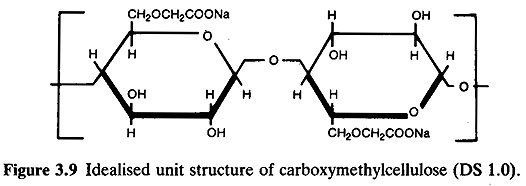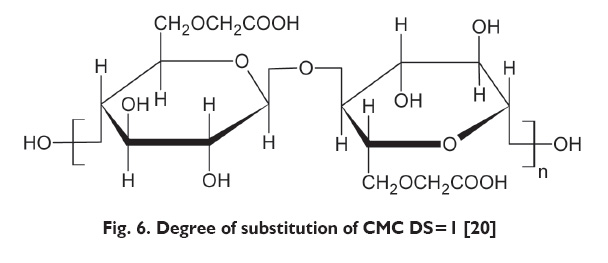Carboxymethyl cellulose
- Carmelose
- E 466
- 9000-11-7 ( acid form )
- 9004-32-4 (sodium salt)
Fixed
- Sodium salt insoluble in organic solvents
- Soluble in water
- Insoluble in water, acids and organic solvents
Carboxymethyl celluloses (CMC), are cellulose ethers, derivatives of cellulose, in which a part of the hydroxyl groups are linked as ether with carboxymethyl groups ( -CH2- COOH). The cellulose is obtained from coniferous and deciduous woods.
Production
Cellulose or pulp is ground and converted with sodium hydroxide solution in the reactive alkali cellulose. The etherification is carried out with chloroacetic acid, the alkali cellulose is converted to carboxymethyl cellulose. The cellulose structure is retained.
Properties
In the acid form of carboxymethyl cellulose are insoluble in water. They are, however, readily soluble in basic solutions.
A generated by cross-linking water-insoluble variant of carboxymethylcellulose is croscarmellose sodium.
Application
Carboxymethyl cellulose is used as detergent additives, binders, thickeners, paper sizing, protective colloid and drilling aids in oil wells.
It is approved in the EU as a food additive number E466. Cellulose derivatives play in addition to the many technical applications in everyday life an important role. So they are used in the food industry and many cosmetic products and pharmaceutical applications. CMC improves the consistency in many foods, such as ice cream (reduction of ice crystal formation ), mayonnaise, sauces, fruit pulp, jelly. In bakery products, the starch retrogradation is delayed, and thus the staling, in dry products, the stability is increased and the Rehydratisierbarkeit.
In the pharmacy, they are used as a tablet disintegrant in the mass concentration of 1% and as formative of a hydrocolloid matrix ( mass concentration of 5-10%).
Economic Importance
The market for cellulose derivatives ( cellulose ethers and cellulose esters) in Germany is estimated at over 100,000 tonnes. Carboxymethyl them are the quantitatively most important market. In 1999, in Germany alone in 2200 t CMC in detergents consumed Since cellulose ether products are made from renewable resources, they are becoming increasingly important, eg as textile auxiliaries for environmentally friendly processes in the textile industry.










